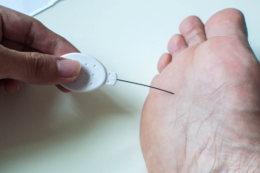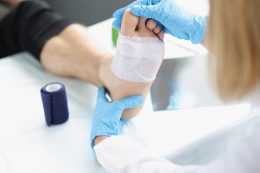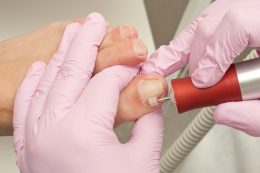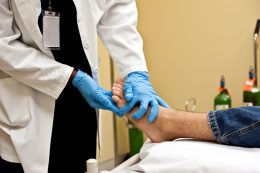Posted by AX.Admin …
4 Causes of Swollen or Inflamed Feet
Swelling and inflammation on your feet can become an inconvenience to your daily routine. Besides making walking around and doing simple tasks difficult, you may also experience pain and discomfort.
There are many reasons for getting inflamed feet, such as the warm weather or standing and walking for long periods. While some causes may not call for urgent treatment, others may come with serious complications, so it’s best to visit a foot doctor when you experience any symptoms. Here are some common causes of swelling and inflammation in your feet:
Injury
Trauma or damage to any part of your body may result in inflammation, which typically leads to swelling. Of course, your feet and ankles are no exception. Sprains, tears, stress fractures, and broken bones are some of the injuries that might cause swollen and inflamed feet. When these foot-related injuries occur, you can use rest, ice, compression, and elevation method to ease symptoms.
Blood Clot
These solid clumps of blood hamper proper blood circulation and lead to swollen feet, ankles, and even legs. A deep vein thrombosis or DVT is a condition that occurs when blood clots form deep in your veins and cause other symptoms, like foot discoloration and fever. You can reduce the risks of DVT through lifestyle changes, such as exercising more and increasing fluid intake.
Infection
Another reason for swollen and inflamed feet is infection. It can occur when you have diabetic wounds or conditions like peripheral neuropathy, which puts you at risk of foot ulcers. Despite that, other situations may lead to an infection, so it’s crucial to always maintain proper foot health.
Medication
If you take certain medications that cause fluid to collect in your feet, it is a likely cause of swelling or inflammation. These include steroids, antidepressants, and diabetes and blood pressure medication. If the swelling occurs frequently, talk to your doctor.
Consult Our Experts at Thomas Podiatry & Associates
Learning about some causes of swollen and inflamed feet is helpful if you experience it yourself. Still, it’s best to have a podiatrist check your feet’s condition to ensure the right diagnosis and treatment you need. Contact us at Thomas Podiatry & Associates in Salisbury, MD for more information about our foot care services.
Flat Feet: Its Causes and Treatments
One of the most common foot disorders is flat feet or fallen arches. This condition occurs when there is minimal to no visible arch on a person’s feet when they stand up, making their heels flatten to the ground. Although some people don’t get symptoms with flat feet, others may experience ankle or heel pain, difficulty walking, swelling, and more.
Because of this, if you have flat feet or notice any potential symptoms of this condition, it’s best to see a podiatrist. Read on to learn more.
What Causes Flat Feet?
Babies and toddlers typically have no arches in their feet as they only develop around the age of six. But, when they don’t, flat feet may occur. This condition may also be caused by genetics, as well as the following:
Obesity – Too much pressure on the feet can change their structure. So, adults with excess weight are more at risk of developing flat arches.
Foot and Ankle Injuries – Broken bones, tendon damage, and other foot and ankle trauma may cause your arches to fall, resulting in flat feet.
Rheumatoid Arthritis – This disease causes the tendons, ligaments, and joints to shift out of their usual positions and change the shape of your feet.
How Are Flat Feet Treated?
While people who don’t experience pain or discomfort won’t require flat feet treatment, those who otherwise do may be treated through various means. Depending on their condition and its severity, some treatments that can be done are:
Nonsteroidal Anti-Inflammatory Drugs (NSAIDs) – Over-the-counter pain medications, like ibuprofen, can be taken if you experience discomfort and inflammation.
Supportive Devices – Custom-made shoes, arch support inserts, and other foot orthotics help ease the pressure on your flat feet and reduce painful symptoms.
Physical Therapy – With the help of a physical therapist, specific stretches and exercises will be recommended to strengthen your muscles and manage flat feet symptoms.
Get in Touch With a Trusted Podiatrist
Having flat feet may hurt your lifestyle in some capacity. So, if you suspect that you have this foot condition or already have it and want to get treated, talk to a podiatrist near you. Reach out to our experts at Thomas Podiatry & Associates in Salisbury, MD for trusted and reliable foot care and treatment services.
How To Manage Blood Sugar for Healthy Feet
One common complication of having diabetes is foot problems. High glucose levels can cause nerve damage and poor blood circulation, which may lead to numbness, sores, and ulcers on the feet. If these conditions become severe, they can result in more serious issues, including foot deformities or amputations.
Hence, it’s crucial to manage your blood sugar. Aside from keeping your diabetes under control, doing so will also help prevent potential diabetic foot problems. Here’s what you should do:
Stay Active
Exercising on a regular basis is beneficial if you have diabetes as it makes your body more sensitive to insulin, lowering your blood sugar. It also helps reduce risks of cardiovascular diseases and reduce stress, which typically causes your glucose levels to spike up.
You don’t need an intense workout routine to stay active. Simply making a habit of walking at least 25-30 minutes a day is enough. You may also consider swimming or upper body workouts if you want to keep your heart rate up without putting too much strain on your feet.
Consume More Whole Foods
A healthy diet makes a huge difference if you want to manage your diabetes. Aside from limiting sugar and carb intake, adding fiber-rich and whole foods to your diet, like leafy greens, fruits, and whole grains, is best. Make sure to hydrate with water instead of choosing sodas or sugary drinks.
Stop Smoking
Apart from an increased risk for conditions like heart disease and stroke, using tobacco also affects how your body controls your blood sugar. Because of this, those who smoke are more likely to develop type 2 diabetes. If you need to quit, consider other nicotine replacements like patches, or talk to your doctor for the best action plan.
Ensure Routine Checkups
In addition to making a few lifestyle changes to control your glucose levels, it’s essential to visit your doctor regularly. A routine checkup allows you to keep track of your diabetes and medication and get professional advice on your diet and exercise.
It’s best to visit your foot doctor at least once a year. They can check for signs of potential foot problems through various tests and assessments and perform the necessary treatments. Your podiatrist may also provide more information on managing diabetic foot symptoms and proper foot care.
Consult a Diabetic Foot Specialist
Learning how to manage your blood sugar is one way you can prevent diabetic feet. Doing so also helps alleviate pain and other symptoms if you already have foot problems caused by diabetes. For a routine checkup or a diabetic foot treatment, reach out to Thomas Podiatry & Associates in Salisbury, MD today.
Signs of a Diabetic Foot Wound
When you have diabetes, you are at a higher risk of developing diabetic foot wounds. High glucose levels typically cause numbness and poor blood circulation, which affects the healing of existing wounds. Without urgent care and proper treatment, these may lead to an infection or more severe complications requiring amputation.
Because of this, it’s crucial to learn about some signs you have a diabetic foot wound. Here are some of them:
Skin Discoloration
Any changes in the skin color around your legs and feet should always be a cause of concern. Depending on your condition, you may notice discoloration that appears as dark red, white, blue, gray, or purple. For severe cases, diabetic feet may develop a black or brown tissue around the wound called eschar, which is typically caused by a lack of healthy blood flow.
Swelling and Redness
Although signs of inflammation are normal when you have a wound, this should only last for no more than a week. If you notice unusual swelling and redness of your wounded feet accompanied by a warm sensation or even pain, visit your foot doctor.
Cuts, Sores, and Blisters That Won’t Heal
If you have a cut, sore, or blister on your foot that is taking ages to heal, you likely have a diabetic wound. This compromised healing process is the result of a common complication of diabetes which affects nerve function called diabetic neuropathy.
Diabetic wounds that don’t heal properly are more prone to infections. So, as soon as you spot a slow-healing foot wound, talk to a podiatrist right away to have it treated and prevent your condition from worsening.
Drainage in Your Socks or Shoes
Some people with diabetes may suffer from a lack of feeling in their feet. So, they may only notice a wound once they find blood, pus, or drainage when they remove their socks or shoes. While this typically happens when there’s an infection, consulting a specialist for a proper diagnosis will help determine your condition.
Talk to a Reliable Foot Doctor
Learning about these signs and symptoms will help you find out if you have a diabetic foot wound. For a complete foot check-up or diabetic foot treatment, contact our experts at Thomas Podiatry & Associates in Salisbury, MD today!
When To See a Podiatrist for an Ingrown Toenail Pain
An ingrown toenail is a common foot condition that occurs when the corner of your toenail grows into the skin beside your nail. This typically affects the big toe and is characterized by pain, swelling, and, in more severe cases, bleeding.
While some ingrown toenails may be treated through home remedies, like antibiotic ointments, others may need professional care. Read on to find out when to visit a podiatrist.
There Are Signs of Infection
Most of the time, ingrown toenails don’t come with serious health complications. But if they’re left untreated for a long time, they may lead to an infection. Signs of an ingrown toenail infection include intense pain, excessive redness, bleeding, discharge of pus, and even the possibility of a fever. An untreated infection may spread to other parts of the body, so consult a foot doctor before symptoms worsen.
Home Remedies Don’t Work
If you notice symptoms of an ingrown toenail, it’s best to treat it at home right away. You may soak your feet in warm saltwater for 15-20 minutes several times a day, or put a topical antibiotic cream on the infected area. But if these treatments don’t cure your foot condition, there might be a bigger problem only a podiatrist can diagnose and treat.
Your Ingrown Toenails Are Recurring
Even if you don’t experience severe symptoms whenever you develop ingrown toenails, getting them frequently is still a cause for concern. This may happen because of ill-fitting shoes, improper toenail cutting, or recurrent foot or toe injuries. To find out the cause of your ingrown toenail pain and get the necessary treatment, talk to a foot specialist.
You Have Diabetes
Since people who have diabetes usually suffer from numbness in their feet, it will be harder for them to spot ingrown toenails. As a result, they may experience more severe symptoms and a higher risk of infection. So, if you have diabetes, it’s crucial to inspect your feet daily and reach out to a podiatrist at the first sign of an ingrown toenail or any other foot disorder.
Reach Out to Thomas Podiatry & Associates
Knowing when to see a professional for an ingrown toenail treatment will help prevent your foot condition from worsening. If you have an ingrown toenail or other foot problem, contact our experts at Thomas Podiatry & Associates in Salisbury, MD.
How To Manage Symptoms of Diabetic Feet
When you have high glucose levels, you are more likely to develop foot diseases such as diabetic neuropathy and peripheral vascular disease. These conditions may cause numbness, pain, tingling, increased risk of infections, and slow-healing injuries.
Aside from the discomfort, diabetic foot problems can also affect your daily life, as they may prevent proper stability and functionality of your feet. So, it’s best to learn how to manage and ease these symptoms. Here are some tips to help you:
Check Your Feet Daily
When you have diabetes, you may experience numbness in your feet, which prevents you from feeling cuts or scratches. So, it’s crucial to inspect them every day. If you do so, you can treat your feet immediately and prevent potential infections from occurring. It would be best if you also looked out for blisters, ingrown toenails, or any signs of swelling, redness, or sore spots. If you find any, talk to your foot doctor.
Wear Proper Footwear
Choosing the right well-fitting footwear lessens the risk of blisters and calluses forming on your feet. So, it’s best to do a foot measurement on your own or with the help of a professional whenever you’re buying new shoes. You should also avoid wearing high heels or pointed shoes since they may put excess strain on the front of your feet.
Monitor Your Blood Sugar
Since high glucose levels are the main reason for diabetic foot issues, keeping them under control is essential. You can do so by maintaining a healthy diet, checking your blood sugar, and taking the necessary medications prescribed by your doctor.
Exercise Regularly
Staying active is greatly beneficial if you have diabetes. Doing so helps improve blood circulation and control your blood sugar levels, easing pain caused by a foot disease. You may start with a regular walking routine or consult your podiatrist on the best form of exercise for your condition.
Stop Smoking
Among the negative effects of smoking is poor blood circulation, which can increase your risk of diabetic foot disease. So, it’s best to break the habit as early as possible if you are a smoker. If you find it difficult, consider a tobacco cessation program.
Consult a Foot Doctor Near You
Now that you know about these tips, you can prevent symptoms of diabetic foot problems from worsening. If you experience unusual pain or want a professional assessment, reach out to Thomas Podiatry & Associates in Salisbury, MD. Our physicians will gladly assist you with your diabetic foot care needs.
Reasons To See a Sports Medicine Doctor
A sports medicine physician specializes in diagnosing, treating, and managing injuries usually sustained from sports or exercise. Besides that, they also help prevent injuries, which is essential if you’ve just recovered from an accident or if you’re returning to an active lifestyle.
You may think a sports medicine doctor only helps professional athletes, but in fact, they care for anyone who needs help with pain or injury from physical activities. Here are some reasons you should visit this specialist:
To Treat a Sports Injury
Whether you’re an amateur or a professional, you may suffer from sudden or chronic injuries that may require a professional’s care. Some of the most common ones include strains, sprains, tendonitis, dislocations, and fractures. A sports medicine doctor can diagnose your condition and provide the proper treatment necessary for full recovery.
To Manage Chronic Pain
One factor that always comes with an injury is pain. While you may relieve some discomfort on your own through first aid treatments, a specialist will be able to suggest the most effective solution for your injury.
Besides oral pain relief medications or injections, a sports medicine specialist may also recommend physical therapy to manage your condition. This is greatly beneficial, especially if you seek a nonsurgical method to ease your pain and discomfort.
To Prevent Future Injuries
Aside from treating and managing pain from current and previous injuries, a sports medicine physician will also help lessen your risks of injury. They can correct unsafe movements, advise on safety training, and even recommend the proper footwear and sports equipment to prevent injuries.
To Improve Physical Performance
Seeing a sports medicine doctor can do wonders if you want to perform better in your chosen sport or activity. Besides helping you train efficiently with an optimized routine, they may also offer nutritional advice so you can get the results you’re aiming for.
Get Reliable Sports Medicine Care
Now that you know more about what a sports medicine doctor does, you now have a better idea of when to reach out to them in the future. If you need a sports injury treatment in Salisbury, MD, talk to our experts at Thomas Podiatry & Associates.
Reasons To See a Sports Medicine Doctor
A sports medicine physician specializes in diagnosing, treating, and managing injuries usually sustained from sports or exercise. Besides that, they also help prevent injuries, which is essential if you’ve just recovered from an accident or if you’re returning to an active lifestyle.
You may think a sports medicine doctor only helps professional athletes, but in fact, they care for anyone who needs help with pain or injury from physical activities. Here are some reasons you should visit this specialist:
To Treat a Sports Injury
Whether you’re an amateur or a professional, you may suffer from sudden or chronic injuries that may require a professional’s care. Some of the most common ones include strains, sprains, tendonitis, dislocations, and fractures. A sports medicine doctor can diagnose your condition and provide the proper treatment necessary for full recovery.
To Manage Chronic Pain
One factor that always comes with an injury is pain. And although you may relieve some discomfort on your own through first aid treatments, a specialist will be able to suggest the most effective solution for your injury.
Besides oral pain relief medications or injections, a sports medicine specialist may also recommend physical therapy to manage your condition. This is greatly beneficial, especially if you seek a nonsurgical method to ease your pain and discomfort.
To Prevent Future Injuries
Aside from treating and managing pain from current and previous injuries, a sports medicine physician will also help lessen your risks of injury. They can correct unsafe movements, advise on safety training, and even recommend the proper footwear and sports equipment to prevent injuries.
To Improve Physical Performance
Seeing a sports medicine doctor can do wonders if you want to perform better in your chosen sport or activity. Besides helping you train efficiently with an optimized routine, they may also offer nutritional advice so you can get the results you’re aiming for.
Get Reliable Sports Medicine Care
Now that you know more about what a sports medicine doctor does, you now have a better idea of when to reach out to them in the future. If you need a sports injury treatment in Salisbury, MD, talk to our experts at Thomas Podiatry & Associates.
5 Most Common Sports Injuries
While doing exercises and sports come with many health benefits, participating in these may still come with risks. During physical activities, different parts of your body may get the brunt of various movements, including your shoulder, knees, foot, and ankles. So, any instances of overuse or overexertion may lead to an injury.
Learning about some common sports injuries will help you prevent and treat any future incidents. Here are some of them:
Strains
This happens when a muscle or tendon is suddenly pulled, overstretched, or torn and is characterized by pain, tenderness, swelling, or muscle spasms. Strains are more likely to occur when you are physically active since you use a wider range of motion for your muscles and tendons. To prevent this, it’s essential to stretch and warm-up properly before doing sports or exercise.
Sprains
A sprain occurs when the ligaments, which connect your bones and joints, stretch, tear, or twist in the wrong direction. This often happens in the elbows, wrists, and ankles. Although similar to strains, sprains can be more painful with more severe cases requiring immobilization treatments.
Fractures
Sports that involve constant impact and contact with people and objects may lead to bone fractures. These typically result from a sharp blow or force to the bone, causing it to crack or completely break. Most fractures happen in the arms, legs, and feet. Depending on the type and severity of your fracture, treatments like braces, splints, and surgery may be necessary.
Achilles Tendinitis
This type of tendinitis occurs when the Achilles tendon, which connects your calf muscles to your heel, is overused. When this happens, you will feel tenderness, stiffness, and difficulty moving the affected area. Achilles tendinitis can be prevented through the use of proper footwear when running and gradually increasing your activity level to avoid strain from overuse.
Plantar Fasciitis
Another common sports injury is plantar fasciitis. This is caused by the overuse of the plantar fascia, which is the tissue that connects the heel bone to your toes. Individuals who frequently run or do activities that place a lot of stress on the heels are at a higher risk of developing this condition. Some treatments for this injury include physical therapy, orthotics, or steroid injections.
Reach Out to Thomas Podiatry & Associates
Sports injuries, whether minor or major, can lead to more severe problems if not treated right away. To get efficient and reliable sports injury treatment, reach out to an expert. Contact us at Thomas Podiatry & Associates in Salisbury, MD today!
5 Most Common Sports Injuries
While doing exercises and sports come with many health benefits, participating in these may still come with risks. During physical activities, different parts of your body may get the brunt of various movements, including your shoulder, knees, foot, and ankles. So, any instances of overuse or overexertion may lead to an injury.
Learning about some common sports injuries will help you prevent and treat any future incidents. Here are some of them:
Strains
This happens when a muscle or tendon is suddenly pulled, overstretched, or torn and is characterized by pain, tenderness, swelling, or muscle spasms. Strains are more likely to occur when you are physically active since you use a wider range of motion for your muscles and tendons. To prevent this, it’s essential to stretch and warm-up properly before doing sports or exercise.
Sprains
A sprain occurs when the ligaments, which connect your bones and joints, stretch, tear, or twist in the wrong direction. This often happens in the elbows, wrists, and ankles. Although similar to strains, sprains can be more painful with more severe cases requiring immobilization treatments.
Fractures
Sports that involve constant impact and contact with people and objects may lead to bone fractures. These typically result from a sharp blow or force to the bone, causing it to crack or completely break. Most fractures happen in the arms, legs, and feet. Depending on the type and severity of your fracture, treatments like braces, splints, and surgery may be necessary.
Achilles Tendinitis
This type of tendinitis occurs when the Achilles tendon, which connects your calf muscles to your heel, is overused. When this happens, you will feel tenderness, stiffness, and difficulty moving the affected area. Achilles tendinitis can be prevented through the use of proper footwear when running and gradually increasing your activity level to avoid strain from overuse.
Plantar Fasciitis
Another common sports injury is plantar fasciitis. This is caused by the overuse of the plantar fascia, which is the tissue that connects the heel bone to your toes. Individuals who frequently run or do activities that place a lot of stress on the heels are at a higher risk of developing this condition. Some treatments for this injury include physical therapy, orthotics, or steroid injections.
Reach Out to Thomas Podiatry & Associates
Sports injuries, whether minor or major, can lead to more severe problems if not treated right away. To get efficient and reliable sports injury treatment, reach out to an expert. Contact us at Thomas Podiatry & Associates in Salisbury, MD today!













